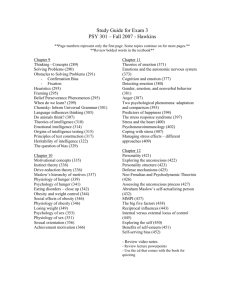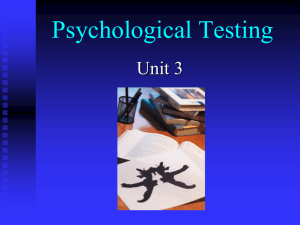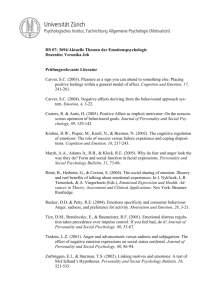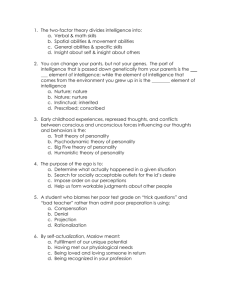Name That Psychologist
advertisement
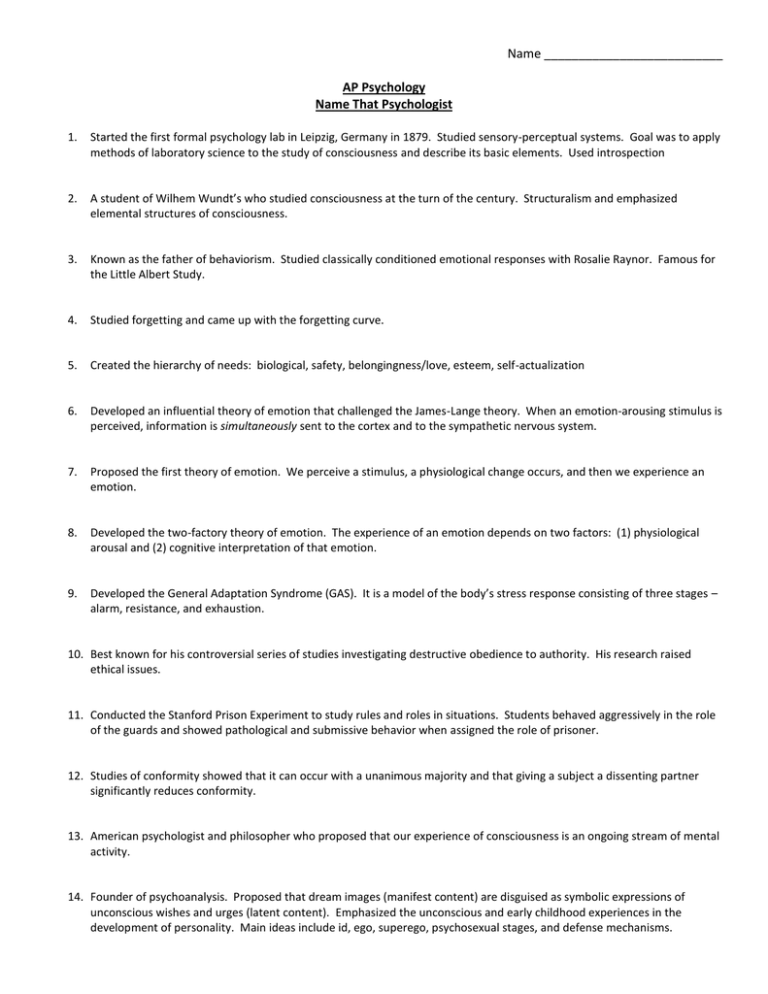
Name __________________________ AP Psychology Name That Psychologist 1. Started the first formal psychology lab in Leipzig, Germany in 1879. Studied sensory-perceptual systems. Goal was to apply methods of laboratory science to the study of consciousness and describe its basic elements. Used introspection 2. A student of Wilhem Wundt’s who studied consciousness at the turn of the century. Structuralism and emphasized elemental structures of consciousness. 3. Known as the father of behaviorism. Studied classically conditioned emotional responses with Rosalie Raynor. Famous for the Little Albert Study. 4. Studied forgetting and came up with the forgetting curve. 5. Created the hierarchy of needs: biological, safety, belongingness/love, esteem, self-actualization 6. Developed an influential theory of emotion that challenged the James-Lange theory. When an emotion-arousing stimulus is perceived, information is simultaneously sent to the cortex and to the sympathetic nervous system. 7. Proposed the first theory of emotion. We perceive a stimulus, a physiological change occurs, and then we experience an emotion. 8. Developed the two-factory theory of emotion. The experience of an emotion depends on two factors: (1) physiological arousal and (2) cognitive interpretation of that emotion. 9. Developed the General Adaptation Syndrome (GAS). It is a model of the body’s stress response consisting of three stages – alarm, resistance, and exhaustion. 10. Best known for his controversial series of studies investigating destructive obedience to authority. His research raised ethical issues. 11. Conducted the Stanford Prison Experiment to study rules and roles in situations. Students behaved aggressively in the role of the guards and showed pathological and submissive behavior when assigned the role of prisoner. 12. Studies of conformity showed that it can occur with a unanimous majority and that giving a subject a dissenting partner significantly reduces conformity. 13. American psychologist and philosopher who proposed that our experience of consciousness is an ongoing stream of mental activity. 14. Founder of psychoanalysis. Proposed that dream images (manifest content) are disguised as symbolic expressions of unconscious wishes and urges (latent content). Emphasized the unconscious and early childhood experiences in the development of personality. Main ideas include id, ego, superego, psychosexual stages, and defense mechanisms. 15. Won the Nobel Prize in 1904. Pioneer of work on classical conditioning with dogs in Russia. 16. Father of operant conditioning. Behavior is controlled by its consequences. Learning is behavior. 17. Known for social-learning theory and observational learning. Learning can also occur by observing. We learn through vicarious reinforcement and punishment. Did classic research with BoBo dolls on aggression and observational learning. 18. Discovered a region in the lower left frontal lobe of the cerebral cortex that is responsible for production of speech. When damaged, expressive aphasia results. 19. Discovered region in left temporal lobe of the cerebral cortex that is responsible for understanding languages. When damaged, receptive aphasia results. 20. Won the Nobel Prize in 1981 for pioneering research on brain hemispheric specialization in split-brain patients. 21. Proposed that people have an innate language acquisition device that allows an understanding of the basic principles of language, a “universal grammar.” 22. French psychologist who developed the first widely used intelligence test (with Theodore Simon), which was scored using mental age. 23. His theory of intelligences states that there are multiple intelligences including verbal-linguistic, logical-mathematical, musical-rhythmic, bodily-kinesthetic, interpersonal, intrapersonal, and spatial. 24. Known for his triarchic theory of intelligence. Includes three forms of intelligence – practical, creative, and analytical. 25. Proposed that “g” should be divided up into fluid intelligence (reasoning, memory, speed of processing) and crystallized intelligence (acquired knowledge). 26. Developed the WAIS and WISC. They are the most widely used intelligence tests with verbal and performance scales. Used normal distribution for scoring. 27. Famous for studies of attachment in rhesus monkeys. Frightened monkeys preferred the cloth mother to the wire mother with a bottle. 28. Proposed a stage theory of psychosocial development that includes a series of conflicts through the lifespan. 29. Theory of moral development. Proposed three distinct levels of moral development – preconventional, conventional, postconventional. 30. Swiss psychologists whose theory proposed children progress through distinct stages of cognitive development – sensorimotor, preoperational, concrete operational, and formal operational. 31. Broke from Freud’s psychoanalytic theory of personality. Stressed self-improvement and emphasized the inferiority complex. 32. Trait theorist that identified three kind of traits – cardinal (organize life around them), central traits (major characteristics), and secondary (specific personal preferences). 33. Broke with Freud’s theory of personality to develop his own psychoanalytic theory. Emphasized the collective unconscious and archetypes. 34. Humanistic personality psychologist. Emphasized unconditional positive regard, too. 35. Emphasized the role of social relationships and culture in personality. Criticized Freud’s description of penis envy. Suggested that basic anxiety was a key component to personality. 36. Developed a projective personality test in 1921 of ambiguous stimuli of symmetrical inkblots. 37. Founded the cognitive psychotherapy called rational emotive therapy (RET). Stressed recognizing and changing irrational beliefs. 38. Argues that facial expressions are innately determined. Facial expressions are programmed as a natural part of the emotion. 39. Known for the Law of Effect. Responses are strengthened when they produce rewards. 40. Known for latent learning (learning in absences of apparent rewards) and cognitive maps (mental representations that act as guides). 41. Known for the linguistic relativity hypothesis – that one’s language determines the nature of one’s thought. 42. Proposed a single general intelligence factor (g). 43. Devised the attachment theory between caregivers and their children – secure, avoidant, anxious-ambivalent. 44. Developed a five stage model of grief – denial, anger, bargaining, depression, and acceptance. 45. Criticized Kohlberg’s male perspective on moral development. Proposed that women’s moral development is based on an ethic of care and responsibility. 46. Studied infant depth perception using the visual cliff. AP Psychology Name That Psychologist List 1. 2. 3. 4. 5. 6. 7. 8. 9. 10. 11. 12. 13. 14. 15. 16. 17. 18. 19. 20. 21. 22. 23. 24. 25. 26. 27. 28. 29. 30. 31. 32. 33. 34. 35. 36. 37. 38. 39. 40. 41. 42. 43. 44. 45. 46. Adler Ainsworth Allport Asch Bandura Binet Broca Cannon-Bard Cattell Chomsky Ebbinghaus Ekman Ellis Erikson Freud Gardner Gazzaniga Gibson Gilligan Harlow Horney James James-Lange Jung Kohlberg Kubler-Ross Maslow Milgram Pavlov Piaget Rogers Rorschach Schachter-Singer Seyle Skinner Spearman Sternberg Thorndike Titchener Tolman Watson Wechsler Wernicke Whorf Wundt Zimbardo


